The Gift of South Dakota
Subscriptions to South Dakota Magazine make great gifts!
Subscribe today — 1 year (6 issues) is just $29!
For the Birds
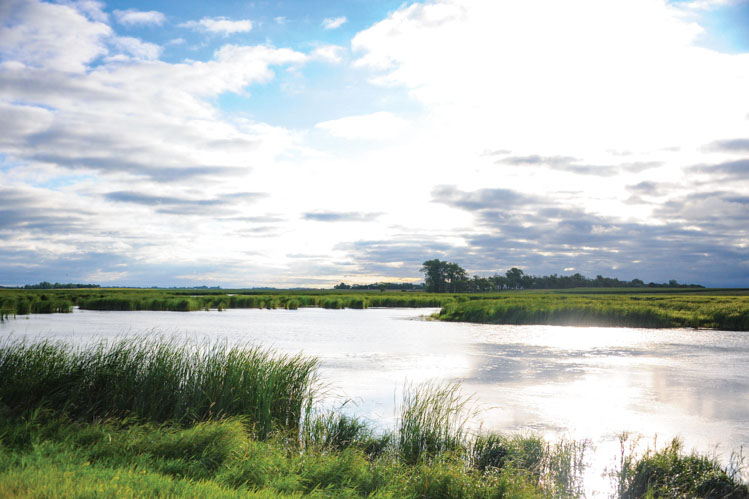 |
| The Sand Lake National Wildlife Refuge in Brown County is among the world's most important waterfowl habitats. |
On a calm summer’s morning at the Sand Lake National Wildlife Refuge, visitors are immersed in the sights and sounds of nature. The sun’s rays peek through early clouds and reflect brightly off the water’s shimmering surface. A light breeze rustles the waist-high grasses. The water moves, but so slowly that it can’t even be heard lapping against the shore. Ducks float among the cattails. A single white gull glides into a cornfield.
This outdoors heaven was in jeopardy a century ago. Wildlife was disappearing as water slowly vanished from the marshland. But thanks to the labor of a future governor, the political skills of a former governor and about 200 men who were glad for any job they could find during the Depression, Sand Lake rejuvenated into one of the most important havens in the world for waterfowl.
The refuge encompasses both Sand and Mud Lake — created by dams built along the James River north of Columbia and northwest of Houghton in Brown County — and the surrounding wetlands. Its 21,498 acres are home to more than 260 bird species, 40 mammal species and a variety of fish, reptiles and amphibians.
Perhaps the best way to observe them is a slow journey along the refuge’s auto tour route, a 15-mile gravel path open generally from April 1 through mid-October, that begins at the visitors center and follows nearly the entire perimeter of Sand Lake. A brochure indicates 12 stops along the way, but traffic was light on the day of our visit so we could stop and go as we pleased.
Almost immediately, we spotted a whitetail deer ambling through the grass. A little farther down the road a white egret stood out against the deep, blue water and tall, green reeds. As the path crossed Houghton Dam, pelicans bobbed near the bridge, sporadically dipping their heads under water in search of fish.
Sand Lake attracts nearly 75,000 visitors each year. Most of them spend just a few hours marveling at its natural wonders. Maybe they imagine what it might be like to live in such a beautiful place, surrounded by diverse flora and fauna. Stephanie Herseth Sandlin doesn’t have to imagine. South Dakota’s former congresswoman and current president of Augustana University in Sioux Falls grew up with Sand Lake in her backyard.
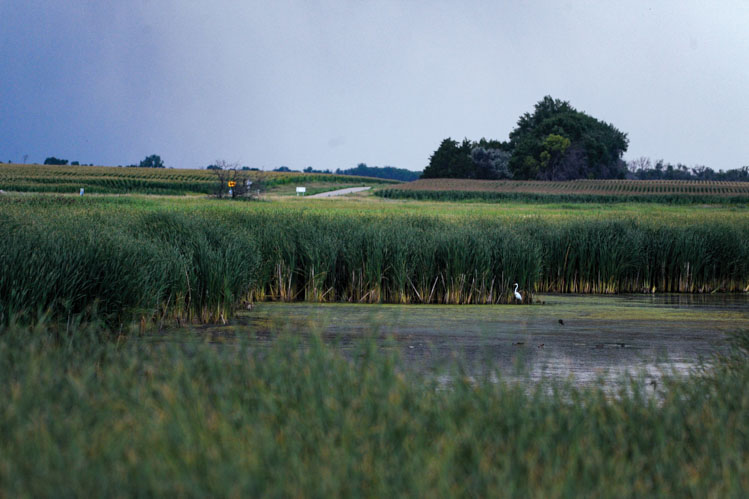 |
| Sand Lake is home to more than 200 species of waterfowl, including a white egret standing among the rushes. |
Her great-grandparents, Lars and Oline Herseth, homesteaded on land about 3 miles southwest of Houghton on the east side of Sand Lake in 1886. The home in which Herseth Sandlin grew up was built in 1909 and features a large picture window facing west toward the water. She remembers watching thunderheads build on the horizon and millions of snow geese blanketing the water in white during the spring migration. “The refuge was a very special part of my upbringing,” Herseth Sandlin says. “We usually had Easter at our house because it’s the family homestead. After the Easter meal, everyone would load up in their cars and take a drive through the refuge so we could spot different birds. My grandmother in particular was a bit of a birder, and that was passed along to all of her kids. I think those of us who grew up on the farm took it for granted. Our cousins who came from Pierre and Northfield, Minnesota, maybe didn’t take it for granted quite so much.”
The Sand Lake area that Lars and Oline Herseth knew changed dramatically thanks to their son Ralph, who was born in 1909 — right about the time that people began to take waterfowl depletion on the Northern Plains seriously. The federal government had issued wildlife protections as early as 1864. Fish, sea birds, bison and elk all benefited through the creation of reserves. Migratory birds became the focus with the Migratory Bird Act of 1913 and subsequent Migratory Bird Treaty of 1916, an agreement between the United States and Great Britain (on behalf of Canada) designed to protect birds that crossed the international boundary.
Numbers did recover, but it soon became evident that sustained success could only be achieved through habitat protection. Those efforts occupied Congress for much of the 1920s, beginning with a bill introduced in 1921 that sought to create refuges funded through sales of a $1 migratory bird hunting license. That measure was defeated. Another bill surfaced in 1924 and appeared destined for a similar fate when its primary sponsor lost his bid for re-election.
That’s when Peter Norbeck got involved. South Dakota’s senator and former governor was a noted conservationist who worked to grow Custer State Park. He became the Migratory Bird Conservation Act’s new champion and immediately encountered resistance, primarily from Sen. James Reed of Missouri. Reed objected to the license fee, opposed the bill’s provision to hire additional federal game wardens to enforce its provisions, and sarcastically said that it would make just as much sense to create sanctuaries for jackrabbits. “To Congress, the whole bird conservation matter is a joke,” Norbeck lamented.
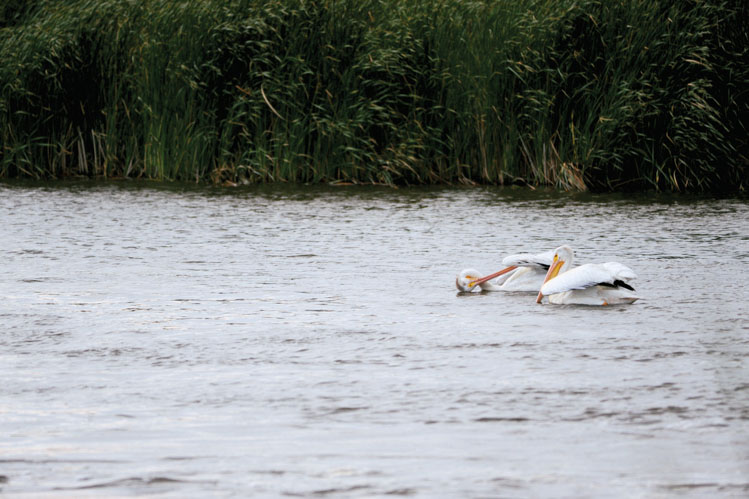 |
| Pelicans float in a cove near the Houghton Dam, the earthwork that separates Sand Lake from Mud Lake. |
Norbeck lost that round, but he returned with another bill in 1927. It retained the $1 federal hunting license, which Norbeck believed would generate $1 million annually for land purchases and law enforcement, and the creation of public hunting grounds adjacent to the refuges. Senators fought, but Norbeck ultimately succeeded in passing a somewhat weakened version of the bill. The steady revenue source had been replaced by an annual congressional appropriation, which came in fits and starts. Lawmakers approved just half the money Norbeck sought over the next four years. Still, the Migratory Bird Conservation Act led to the creation of 22 refuges encompassing more than 1 million acres by 1933.
In South Dakota, experts pointed to marshy Sand Lake as an ideal location. Families, including the Herseths, donated land to help make the refuge a reality. And who better to lead the effort than the young man who grew up on its eastern shore?
Ralph Herseth was the 26-year-old supervisor of the Sand Lake Civilian Conservation Corps camp. When Sand Lake was officially added to the national refuge system in 1935, he and his 200 men got to work building dams, digging ditches and planting the uplands to provide food and cover. They moved 120,000 cubic yards of dirt to build eight islands and planted thousands of trees and shrubs. The men also constructed a 108-foot-tall steel observation tower that visitors can still climb. It provides a beautiful, panoramic view of the refuge, though the ascent is not for everyone. “You look around and it’s a nice view, but if it’s a windy day there’s something about being up there and feeling it sway,” Herseth Sandlin says. “We took my husband out there when we were dating, the first time he came to visit the farm. I don’t know that he wanted to stay up there too long, and he hasn’t asked to go back up.”
South Dakota ultimately became home to six national wildlife refuges, all managed by the U.S. Fish and Wildlife Service: Sand Lake, Waubay, Karl Mundt, Lake Andes, Lacreek and Bear Butte (managed as part of Lacreek). Each refuge boasts its own claim to wildlife fame. Bald eagles draw visitors to the Mundt Refuge along the Missouri River, trumpeter swans spend part of the year at Lacreek near Martin, and Sand Lake is home to the world’s largest breeding colony of Franklin’s gulls. Sand Lake has been designated a Globally Important Birding Area and was recognized by the American Bird Conservancy as one of the top 15 birding sites in North America.
After Sand Lake’s completion, the Herseth family enjoyed its benefits. Ralph and his wife, Lorna, hosted family and friends for hunting excursions on their land adjoining the refuge. A lifelong advocate of natural resources, Ralph Herseth brought those principles to Pierre when he served as governor from 1959 to 1961. Among his achievements was passage of the South Dakota Conservancy Law, the first step in the proposed Oahe Irrigation Project, because, he noted, “water was more precious than oil.”
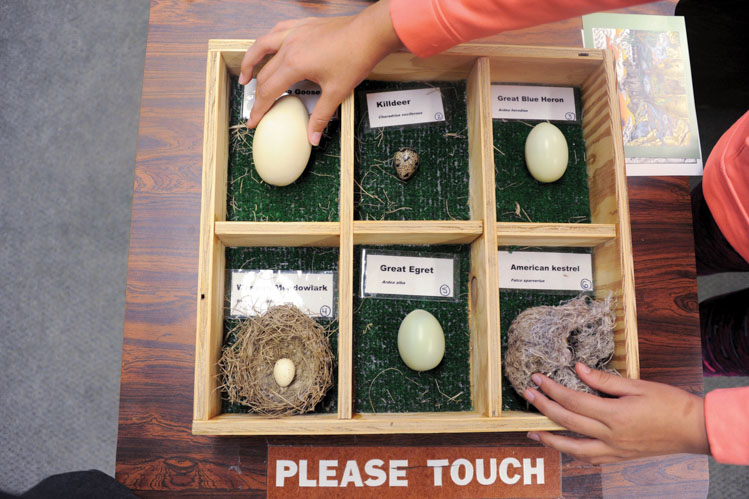 |
| Hands-on exhibits inside the Sand Lake visitors center help children learn about its variety of wildlife. |
Meanwhile, Sand Lake became a playground for Herseth children. Herseth Sandlin and her brother often explored the refuge on foot or by three-wheeler. One winter, her father, Lars, bought a contraption that resembled a sailboat on ice skates that the family used to glide across the frozen pond.
It also offered early lessons in profits and losses. When Herseth Sandlin was 9, her father suggested she raise pheasants. The refuge offered $1 for every chick raised to maturity, banded and released within its borders. She began with 100 chicks, but barn cats took around 30 of them.
She tried again the next year, this time with 200 chicks. She built sturdy chicken wire fencing and eventually had nearly 200 fully healthy ringneck pheasants. “I banded them, put them out in the refuge and two days later we had the 1981 hail storm, and I’m not sure any of them survived,” she says. “But I still got my payment.”
If you’re traveling Highway 10, consider veering off at Sand Lake and spending an hour or two among the solitude. Let the grasses sway around you. Listen for the distinct song of meadowlarks. Look for the bright blue bills of ruddy ducks or the red faces and white rings of pheasants (maybe the Augie president’s birds weren’t doomed). All in all, Sand Lake provides a welcome respite for man and bird alike.
Editor’s Note: This story is revised from the May/June 2019 issue of South Dakota Magazine. To order a copy or to subscribe, call (800) 456-5117.


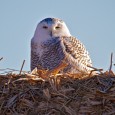

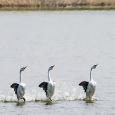





Comments
Loved your article & thank you for telling the most interesting story of its beginning.
Marg Forseth